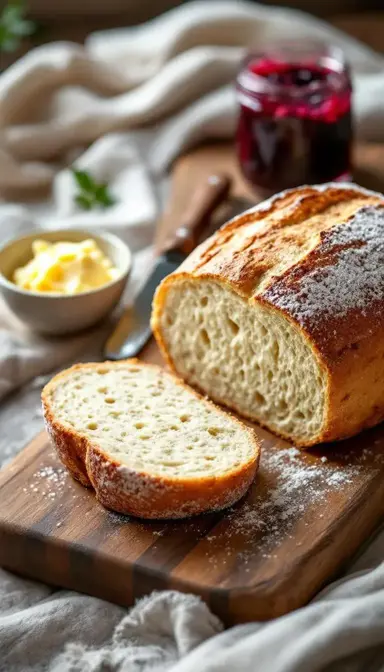There’s something almost magical about pulling a loaf of crusty sourdough from the oven. That first crackle as it cools, the way the steam escapes in little whispers, the intoxicating aroma of toasted wheat and tangy fermentation—it’s a sensory experience that never gets old. This isn’t just bread; it’s a living thing, shaped by time, wild yeast, and your own two hands.
I remember my first attempt at sourdough. It was a disaster—dense, gummy, more like a doorstop than dinner. But that’s the beauty of this craft. Every loaf teaches you something new, and when you finally nail it, the victory is sweeter than any store-bought slice.
Why This Recipe Works
- Wild fermentation gives sourdough its signature tang and makes it easier on the stomach. The natural acids produced during fermentation break down gluten and phytic acid, making nutrients more accessible.
- High hydration isn’t just a fancy term—it’s the secret to those gorgeous, irregular holes in the crumb. The extra water creates steam pockets during baking, resulting in an open, airy texture.
- Steam is non-negotiable. Without it, you’ll end up with a sad, pale crust. A Dutch oven (or a baking sheet with a pan of water underneath) mimics professional steam-injected ovens, giving you that blistered, golden exterior.
Essential Ingredients & Tools
Ingredients for the Dough
- 500g bread flour – The backbone of your loaf. High protein means strong gluten, which means a chewy, structured crumb. All-purpose flour can be substituted, but expect a softer texture.
- 350g water – Temperature matters here. Too cold, and your yeast sleeps; too hot, and you kill it. Aim for 75°F—just warm enough to wake the starter without shocking it.
- 100g active sourdough starter – This is your leavening agent, your flavor booster, your bread’s soul. If it’s not bubbly and lively (it should float in water), your loaf won’t rise properly.
- 10g salt – Not just for taste. Salt tightens gluten and regulates fermentation speed.
Tools
- Dutch oven – The MVP of home sourdough baking. No Dutch oven? Use a heavy pot with a tight-fitting lid or a baking stone with a steam pan underneath.
- Bench scraper – A sticky dough’s best friend. A large spatula or even a butter knife can work in a pinch.
- Banneton (proofing basket) – That beautiful spiral on your loaf? Thank this basket. No banneton? A bowl lined with a floured kitchen towel works too.
- Lame or razor blade – Scoring isn’t just for looks—it’s how your bread breathes as it bakes. A sharp paring knife can substitute.
Serves: 1 loaf | Prep time: 30 mins | Cook time: 45 mins | Total time: 24–36 hrs (includes fermentation)
How to Make The Art of Crusty Sourdough: A Love Letter to Bread
- Feed Your Starter – Like waking a sleeping bear, your starter needs time to get going. Feed it 6–12 hours before mixing your dough. A ripe starter should float in water—if it sinks, give it more time.
- Autolyse – Fancy word for letting flour and water hang out. Mix just the 500g bread flour and 350g water (no salt yet!) and let rest for 30–60 minutes. This hydrates the flour and jumpstarts gluten development naturally, making the dough easier to handle later.
- Mix in Starter & Salt – Now the real work begins. Add the 100g active sourdough starter and 10g salt to the autolysed dough. Knead gently by hand (5–7 minutes) or with a mixer (3–4 minutes) until smooth. The dough should pass the windowpane test—stretch a small piece; if it’s thin enough to see light through without tearing, gluten is fully developed.
- Bulk Fermentation – This is where patience pays off. Let the dough rise at room temperature (70–75°F) for 4–6 hours. For the first 2 hours, perform coil folds every 30 minutes—gently lifting and folding the dough onto itself to strengthen gluten without overworking it.
- Shape & Cold Proof – Pre-shape the dough into a round, let it rest uncovered for 20 minutes (this relaxes gluten for easier final shaping), then tighten into a boule or batard. Place seam-side up in a floured banneton. Refrigerate for 12–18 hours. This slow fermentation deepens flavor and firms up the dough for easier scoring.
- Bake with Steam – Preheat your Dutch oven at 500°F (260°C) for 30 minutes. Score your dough with a lame (a sharp blade held at a 30° angle for “ears”), then bake covered for 20 minutes. Remove the lid, reduce heat to 450°F (230°C), and bake 25 minutes until deeply golden.
Chef’s Wisdom
- Fermentation is flavor. Cooler temps (68°F) favor acetic acid, giving a sharper tang; warmer (75°F) favors lactic acid for a milder flavor. Use an aliquot jar—a small sample of dough in a glass—to track rise percentage without disturbing the main batch.
- Scoring is science and art. A deep cut (½”) at a shallow angle creates that iconic “ear.” Dull blades drag—use a razor for clean lines. Spritz the loaf with water pre-scoring to reduce sticking.
- Dough talks. Underproofed? It’s dense and resists scoring. Overproofed? It collapses when poked. Look for a 30–50% volume increase during bulk fermentation—not double, as with yeast breads.
Storage & Freshness Guide
- Short-term: Store cooled bread cut-side down on a wooden board for 1–2 days. The crust stays crisp, while the crumb retains moisture. Avoid plastic bags—they trap moisture and soften the crust.
- Freezing: Wrap whole loaves in double-layer foil (up to 3 months). Reheat frozen bread at 350°F (175°C) for 10–12 minutes to restore freshness. Slicing before freezing lets you toast individual portions straight from the freezer.
- Reviving stale bread: Spritz stale slices with water and bake at 400°F (200°C) for 5 minutes. For next-level revival, soak the loaf briefly under running water before reheating—this rehydrates the crumb without making it gummy.
Ingredient Variations and Their Impact
- Whole wheat flour: Swap 20–30% of bread flour for nutty depth. Toast the flour lightly before mixing to enhance earthy notes. Increase hydration by 5%—whole wheat absorbs more water.
- Rye flour: Use 15% rye for complex, earthy flavor. Pair with caraway seeds (1 tbsp) for classic deli-rye character. Add 1–2 extra folds during bulk fermentation—rye weakens gluten.
- Seeded loaf: Fold in 50g toasted seeds (sunflower, pumpkin, flax) during shaping. Soak seeds overnight for easier digestion and plump texture. Reduce water in the main dough by 10g to account for seed moisture.
Perfect Pairings
Complementary Dishes
- French Onion Soup: The bread’s sturdy crust holds up to broth, while its tang cuts through the soup’s richness. Toast slices with Gruyère for classic croûtes.
- Avocado Toast: Sourdough’s chewiness contrasts creamy avocado. Sprinkle with chili flakes and flaky salt for balance.
Drinks
- Chardonnay: The wine’s buttery notes mirror sourdough’s lactic tang. Opt for an oaked version for toasted undertones.
- Cold Brew Coffee: Bright acidity in coffee highlights the bread’s sour notes. Ideal for morning toast with almond butter.
Something Sweet
- Honey Butter: Whip softened butter with honey (2:1 ratio) for a spread that leans into sourdough’s rustic sweetness.
- Berry Jam: Tart berries (like raspberry or blackberry) echo the loaf’s acidity. Serve with ricotta for texture contrast.
Baking sourdough is a journey, not a destination. Some loaves will be perfect; others will teach you. But every one is worth the effort. Happy baking, friends. May your crusts be crisp and your crumb open.

Crusty Sourdough Bread (Crackly Crust, Open Crumb, Bakery Vibes)
Learn to bake perfect Crusty Sourdough Bread at home. My step-by-step guide delivers that tangy flavor and crispy crust you crave. Start your sourdough journey today!
Ingredients
For the Dough
-
500 g bread flour
-
350 g water (75°F/24°C)
-
100 g active sourdough starter
-
10 g salt
Instructions
-
Feed your starter 6–12 hours before mixing dough. It should be bubbly and float in water.01
-
Mix 500g bread flour and 350g water (no salt) and let rest for 30–60 minutes (autolyse).02
-
Add 100g active sourdough starter and 10g salt. Knead until dough passes the windowpane test.03
-
Let dough rise at room temperature for 4–6 hours, with coil folds every 30 minutes for the first 2 hours.04
-
Shape dough into a boule or batard, place in a floured banneton, and refrigerate for 12–18 hours.05
-
Preheat Dutch oven at 500°F (260°C) for 30 minutes. Score dough and bake covered for 20 minutes.06
-
Uncover, reduce heat to 450°F (230°C), and bake 25 minutes until deeply golden.07



